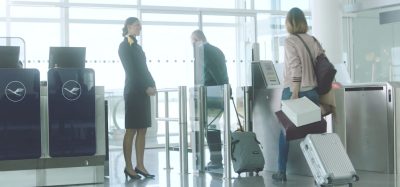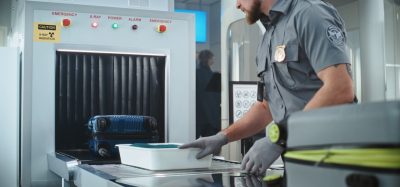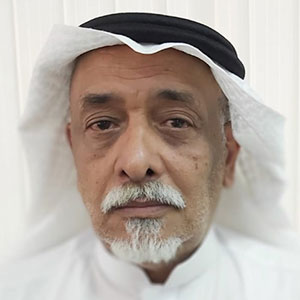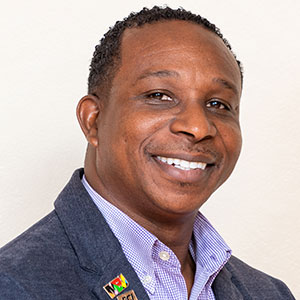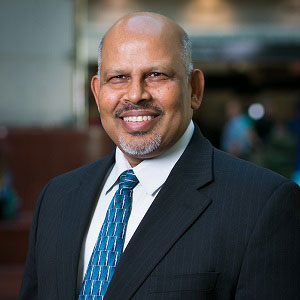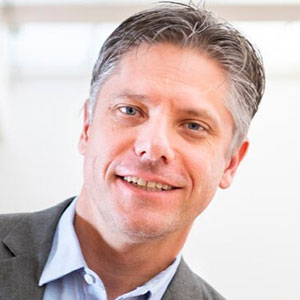AI, automation and the airport of the future: Inside Fraport’s digital factory
Posted: 1 October 2025 | Claus Grunow | No comments yet
Frankfurt Airport is embracing a future shaped by AI, robotics and open innovation. Speaking to International Airport Review, Claus Grunow, Vice President Corporate Strategy and Digitalisation at Fraport AG, shares how the operator is using technology to drive efficiency, empower staff and keep pace with global transformation.
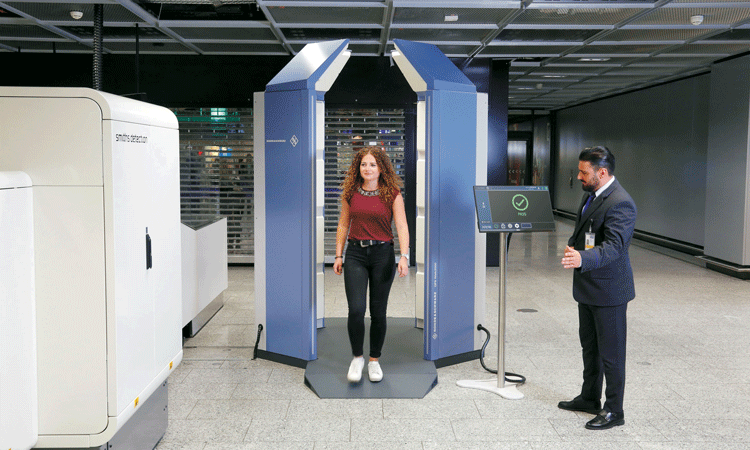

Frankfurt Airport was the first airport in the world to regularly deploy walkthrough security scanners which make the security experience faster and more seamless for passengers. Copyright: Fraport
Strategic AI: from dispatch to noise complaints
Fraport’s Digital Factory is a virtual organisational unit described as an in-house ‘solution partner’. It helps Fraport’s business units at Frankfurt Airport and the airports it operates abroad solve challenges. The function of the Digital Factory is to drive digital transformation of customers’ processes, and spot emerging innovations. To do this, they identify companies who are best-in-class at what they do and introduce the solution at Fraport.
Fraport’s digital transformation is anchored in its AI@Fraport initiative, launched two years ago. It includes everything from operational enhancements to AI chatbots for staff.
Two major AI projects are currently underway: “One is about turnaround management—predicting all the processes that are needed on ground to speed up the turnaround process and get the plane off the ground quicker,” Claus explained. “The second is on the dispatch of our ground handling crews. We have 62 million passengers per year and thousands of people working in ground handling, but 10 people employed to focus solely on the dispatch work. We strongly believe that 80 to 90% of those tasks can be automated by using AI.” This will free up those 10 people to do things that are more challenging than assigning tasks and calling people.”
Join us live: Shaping the Next Generation of Hold Baggage and Air Cargo Screening
Join us live for an insightful webinar on 11th December at 14:00 GMT, in collaboration with Smiths Detection, as we explore the strategic balance of operational efficiency, regulatory compliance, and sustainability in high-volume security environments.
This session offers a focused look into future-proofing your security strategy.
Key learning points
- Cost Reduction: Strategies to minimize bag travel time while simultaneously reducing operational costs.
- Regulatory Roadmap: Insights into the next wave of regulatory changes and their impact on future investment decisions.
- Sustainable Systems: Practical approaches to building sustainability into security systems and lowering the total cost of ownership (TCO).
- Scalable Solutions: Real-world examples of scalable systems supporting current airport growth and preparing for tomorrow.
Register now for expert insights, case studies, and actionable strategies on operational efficiency!
Crucially, Fraport’s strategy isn’t about workforce reduction. “One of our major ethical guidelines is that we are not using AI to substitute any employee,” Claus stressed. Instead, automation is seen as an enabler to meet increasing demand without increasing headcount: “We have a growth case and so it’s enabling us to cope with the demand while keeping the workforce on the level that we have today.”
Fraport even helped set the government’s framework for AI on ethical guidelines. “As early as 2020 in the middle of the COVID crisis, we aligned with the government of the state of Hessen and were part of the group to set up those ethical standards on a state level. It was eventually taken to federal level in Berlin and then to the EU. So today EU regulation on AI ethical guidelines is derived out of the work we did in the group in 2020.”
When asked if governments are still behind in the regulation of AI, Claus replies: “I am not sure you can be ahead of it. You get more than one new large language model (LLM) every week. It’s a question of how you can set a framework that allows the innovation, not kill the innovation, and at the same time have a clear boundary of what is not allowed. I think that’s what governments can really do.”
This is why Claus recommends airports work with their governments to come up with frameworks which will help prevent them from bringing in regulations that will limit your possibilities.
FraportGPT
In early 2024, Fraport launched FraportGPT, a company-secure large language model available to all employees. “Most people seem to be using ChatGPT, however that comes with security problems because you are feeding your company’s data into some cloud you cannot control. So, our employees are not allowed to use the open GPTs anymore,” Claus said. “FraportGPT is a compliant alternative.”
The tool is now generating 3,000 interactions per day, serving as a trusted entry point for staff to engage with AI.
Claus sees FraportGPT as much a cultural shift as a technical one: “It’s probably the easiest way for an employee to interact with an AI, because it’s in daily use.”
What kind of questions can you ask it? And would it answer how to hack into Fraport’s IT system for example?
“It would probably say ‘nice try!’ A few areas are blocked for good reason,” laughed Claus, “but you can ask it anything.”
Future functionality will include document uploads, internal data querying and application in compliance workflows.”
I personally believe that AI is going to change the world, the airports and the way we operate airports.
Robots below ground
While robots in terminals are increasingly common, Fraport’s most innovative use of robotics lies hidden beneath the surface.
“We’ve just finished a project on robotic condition assessment of the sewer network,” Claus revealed. The airport has 40km of sewer networks, and previously, a third-party inspected the system at great cost. Now, drones can fly through bigger pipes and autonomous ground robots can go through the smaller pipes and collect 360-degree, 4K images, with AI generating inspection reports. “It’s an amazing efficiency gain.”
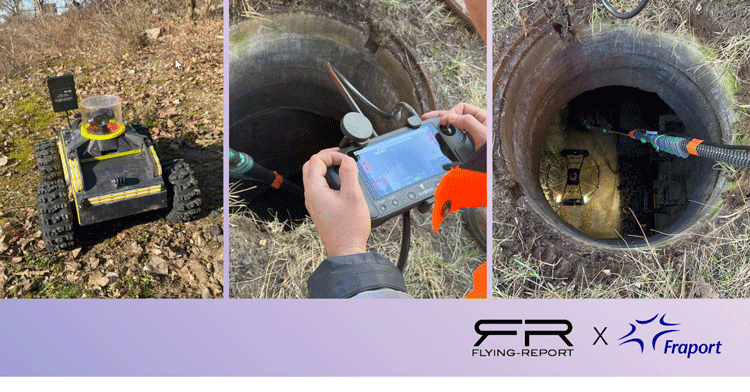

Fraport has been working on a project to find a technical solution for the automation of camera inspections of their sewer network. The pilot involved drones and rovers with Flying-Report. The MVP phase was considered to be successful. Copyright: Fraport / Flying-Report
Robotics really is a game-changer for airports. “The efficiency gain in airports has not been that high over the past few decades. Robotics can really make a difference to this because there are many repetitive tasks,” he explained.
Feasible use cases include baggage handling and autonomous airfield vehicles.
Recalling a ride he took in an autonomous car when in San Francisco, Claus said: “If a system is able to handle a city like San Francisco, it should easily be able to handle an airport.”
To accelerate adoption, Fraport has teamed up with a consortium of 120 international airports to approach major tech companies: “We came up with an initiative called AeroAS autonomous airport operations programme and we are trying to convince a big tech company to bring their solution to our airfield.”
Walkthrough security
Frankfurt Airport has recently become the first airport in the world to regularly deploy walkthrough security scanners. Passengers simply drop their bags into a CT scanner, walk alongside it, and are scanned simultaneously. “It’s quite impressive,” Claus said. “You don’t take off your jacket or take anything out of your pockets, you just walk!”
One unexpected challenge? Passengers moving too slowly. “In the first days, we experienced people taking a slower walk to give the machine the chance to scan, but they got an error message.”
It appears for now, that seasoned travellers are best at using it.
“After you’ve done it once or twice, you know the speed to walk at, but if you are a new customer it is going to be tricky.” Solutions may include moving belts or clearer visual prompts, but the trial is already highlighting how future checkpoints can blend speed with safety.
Building a culture of open innovation
Innovation at Fraport is not limited to in-house projects. The airport’s Open Pitch Day invites everyone – whether that is companies, employees, or even former employees – who think they can make an impact on aviation of the future to submit an idea. Twice a year, they collect the responses, a round of interviews follows. From this, four to six promising ideas are selected and invited to a 20-minute pitch to the management board. From these, one or two is chosen for a pilot.
We’re combining the idea of open innovation with a fast process mindset.
“More than 300 companies have shown interest over the last five Open Pitch Days,” Claus shared. “It’s probably the fastest process to get a project started at an airport, as the traditional process can sometimes take up to two years, and for many companies such as start-ups this is just too long. We’re combining the idea of open innovation with a fast process mindset.”
Recent successful pitches include autonomous wheelchairs and a project to modernise cable infrastructure—currently managed by one person via a giant Excel spreadsheet. “The current system is not very future proof, so we are going to be implementing that one.”
Looking beyond aviation
Claus believes in learning from other industries—particularly mining, where predictive maintenance is mature and they use similar ventilation systems, the cruise sector, which has rebounded strongly since COVID with high customer satisfaction, and Frankfurt’s football team – Eintracht Frankfurt who collaborate with Fraport around passenger flow, signage and even co-developed autonomous lawnmowers for both the pitch and the airfield.
The takeaway: communicate, collaborate, transform
Fraport’s Digital Factory is a productive one.
For airport leaders looking to incorporate new technologies, his advice is clear: “You cannot communicate enough. Communication from the top management, board of management, supervisory board, etc. is crucial. You must get them involved and get their buy-in, and then all the way down to the ops teams. They need to start using the technology to get a feel for what it does, what it can’t do. Understanding this is vital to the success of the transformation.”
As airports gear up for a more digital, data-driven future, Fraport’s message is that innovation is not just a project—it’s a mindset.
Claus Grunow will be speaking at International Airport Summit 2025 on the Day 2 panel ‘The robots are coming! Dealing with workforce shortages with robotics and autonomy’. Want to discuss robotics and autonomous technology with him further and get his advice? Make sure you secure your place at the summit taking place in Berlin on 19-20 November by registering for your FREE ticket now.


The International Airport Summit is open for registration!
Date: 19 – 20 November 2025
Location: JW Marriott Hotel Berlin
At our flagship event of the year, we will dive into the future of airport operations, with expert-led sessions on passenger experience, innovative smart technologies, baggage handling, airside operations, data, security, and sustainability.
This is where global airport leaders come together to share insights, challenges, and real-world solutions.
Limited complimentary passes are available for eligible professionals – first come, first served!
Related topics
Airport development, Artificial intelligence (AI), Autonomous Technology, Digital transformation, Innovation, International Airport Summit, New technologies, Operational efficiency, Regulation and Legislation, Robotics, Security, Workforce



